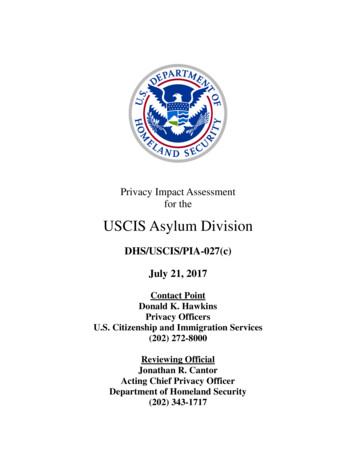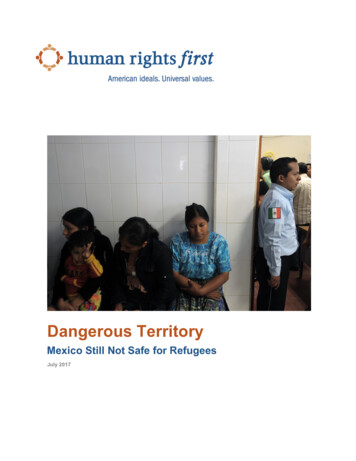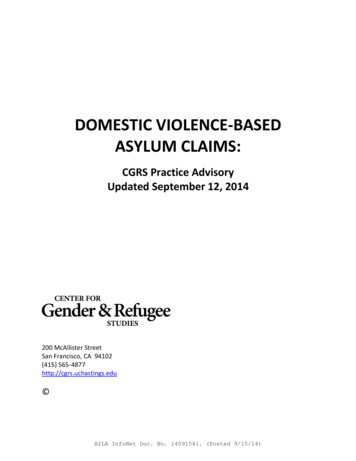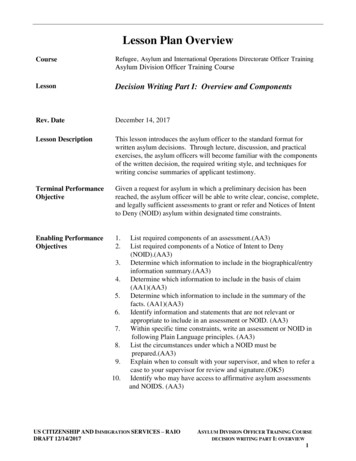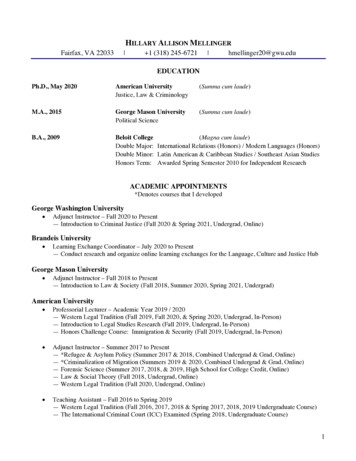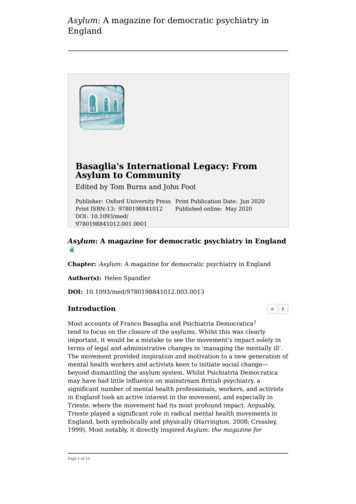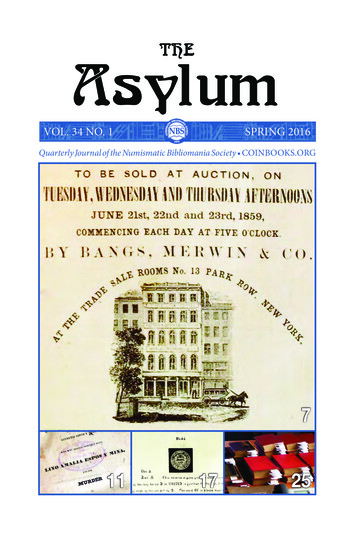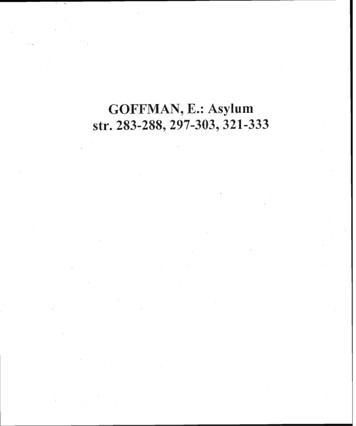
Transcription
GOFFMAN, E.: Asylumstr. 283-288,297-303,321-333
INeach society there are favoured ways in which two individuaIscan approacb and have dealings with each other, for example, askindred to kindred, or high caste to low. Each of these frameworks for contact can be at once a source of identity, a guide forideal conduct, and a basis of both solidarity and divisiveness.Each framework involves a set of interdependent assumptionsthat fit together to form a kind of model. In every case we findthat characteristic pressures prevent persons from fully realizingthe ideal and that the resulting deviations have characteristicreverberations. The student of society can therefore use forhis purposes the same models that members of society use fortheirs.In our Western society, an important way in which two individuals may deal with each other' is as server and served. Byexploring the assumptions and ideals behind this occupationalrelationship, I think we can understand some of the problems ofmental hospitalization.Specialized occupational tasks can be divided into two categories, one where the practitioner 'meets the public' through hiswork, a second where he does not, performing it only for theestablished members of his work organization. I assume that theproblem of facing the public and of controlling it is sufficientlycentral to merit treating together a11 who experience it. Thismeans that a hardware-store clerk and a factory tool-bin man areto be separated for purposes of study, in spite of similarities inwhat they do.Among tasks requiring the performer to meet the public, twokinds may be distinguished, one where the public consists of asequence of individuals, and another where it consists of a sequence of audiences. A dentist performs the first kind of task, acomedian the second.
284ASYLUMSTasks which require the practitioner to meet the public (ineither of its fonns) vary in the degree to which they are presentedto this public as a personal service, that is, as an assistance desired by the recipient. A personal-service occupation may be defined, ideally, as one whose practitioner performs a specializedpersonal service for a set of individuals where the service requireshim to engage in direct personal communication with each ofthem and where he is not otherwise bound to the persons heserves.1 By this definition the process of being served a summons,for example, is not a personal service for the person served. Apsychologist who sells vocational testing to persons who want tolearn about their aptitudes is performing a personal service, butifhe tests the same persons for the empIoyrnent officeof an organization they are merely the subjects of his work and not his clients.So also, in spite of the language of census takers, I exclude domestic servants from the category of servers, since a maid has amistress, not a public, and I exclude charwomen, since they donot routinely engage in direct communication with those whowalk on their clean floors.In this paper I want to consider personal-service occupationsas here defined, but I shall include some practitioners who do notentirely fit my definition, since the ideal on which it is based drawspeople who are not in a position to conform to it. Deviationsfrom an ideal imposed by self or others create problems of identity that the student must understand in terms of the ideal - andunderstand differentlydepending on the relation of the deviationto the ideal: a high-pressure car salesman and an insurancecompany doctor both provide something less than a personal service, but for a different framework of reasons.A traditional means of classifying personal-service occupationsis by the honour accorded them, with theliberal professionsfallingat one extreme and the humble trades and crafts at the other.This can be an obscuring distinction, separating by rank those1 . Sociological interest in service occupations stems largely from EverettC. Hughes and is documented in the work of his students at the Universityof Chicago, especially Oswald Hall and Howard S. Becker. See especiallythe fatter's 'The Professional Dance Musician and His Audience'. AmericanJOWMIof Sociology. LVII (1951). pp. 1 3 6 4 4 .M E D I C A L M O D E L A N D M E N T A L HOSPITALIZATION 285who are similar in spirit. The division I want to employ places atone extreme those, such as ticket-takers or telephone operators,who perform a perfunctory technical service, and at the otherthose with an expertness that involves a rational, demonstrablecompetence that can be exercised as an end in itself and cannotreasonably be acquired by the person who is served. Perfunctoryservers tend to have customers, 'parties', or applicants; expertservers tend to have clients. Both types of servers are likely tohave some independence from the persons they serve, but onlyexperts are in a position to build that independenceinto a solemnand dignified role. It is the social and moral assumptions underlying the practice of expert, rather than perfunctory, servicingthat I want to consider in this paper.I suggest that the ideals underlying expert servicing in oursociety are rooted in the case where the server has a complexphysical system to repair, construct, or tinker with - the systemhere being the client's personal object or possession. Hereafter inthis paper when I use the term service relation (or occupation)this pure case will be implied unless the context necessitates amore careful reference.We deal with a triangle - practitioner, object, owner - and onethat has played an important historical role in Western society.Every large society has expert servers, but no society has givensuch service more weight than has ours. Ours is a service society,so much so that even such institutions as stores come to followthis style in word if not in fact, responding to the need of bothclerks and customers to feel that expert personal service is beingprovided even while they despair of realizing it.The type of social relationship I will consider in this paper isone where some persons (clients) place themselves in the handsof other persons (servers). Ideally, the client brings to this relationship respect for the server's technical competence and trust thathe will use it ethically; he also brings gratitude and a fee. On theother side, the server brings: an esoteric and empirically effectivecompetence, and a willingness to place it at the client's disposal;professional discretion; a voluntary circumspection, leading himto exhibit a disciplined unconcern with the client's other affairsor even (in the last analysis) with why the client should want the
286ASYLUMSservice in the &st place; and, finally, an unservile civility.2 This,then, is the tinkering service.We can begin to understand the service relation by examiningthe concept of the fee. There is a double sense in which a fee is nota price.3 Traditionally a fee is anything other than what the serviceis worth. When services are performed whose worth to the clientat the time is very great, the server is ideally supposed to restricthimself to a fee determined by tradition - presumably what theserver needs to keep himself in decent circumstances while he d evotes his life to his calling. On the other hand, when very minorservices are performed, the server feels obliged either to forgocharging altogether or to charge a relatively large flat fee, thuspreventing his time from being trifled with or his contribution(and ultimately himself) from being measured by a scale that canapproach zero.4 When he performs major services for very poorclients, the server may feel that charging no fee is more dignified(and safer) than a reduced fee.5 The server thus avoids dancing tothe client's tune, or even bargaining, and is able to show that he ismotivated by a disinterested involvement in his work. And sincehis work is the tinkering kind, which has t o do with nicely closedand nicely real physical systems, it is precisely the kind of work inwhich disinterested involvement is possible: a repair or construction job that is good is also one that the server can identify with;this adds a basis of autonomous interest to the job itself. Pre2. This description of the service relationship draws heavily on Parson'spaper, 'The Professions and the Social Structure', which I feel is stillthe leading statement in this area. See also Talcott Parsons and NeilSmelser, Economy and Sociefy (Glencoe, Ill.: The Free Press, 1956), pp.152-3.3. See, for example, A. M. Carr-Saunders and P. A. Wilson, The Professions (Oxford: The Clarendon Press, 1933). section 'Fees and Salaries'pp. 451 -60.4. The more lowly the tinkering trade, the more need the server may haveto forgo charging for certain minor but skilled services. Among shoemakers these acts of noblesse oblige can become lordly indeed, just at a timein history when lords can no longer afford the original version.5. Carr-Saundersand Wilson, op. cit., p. 452: 'In most other professions[other than accountancy] the associations attempt to induce their membersnot to undercut, though objection is never raised to the remission of feeswhen the client is poor.'MEDICAL M O D E L A N D M E N T A LHOSPITALIZATION287sumably the server's remaining motivation is to help mankind assuch.The server's attachment to his conception of himself as a disinterested expert, and his readiness to relate to persons on thebasis of it, is a kind of secular vow of chastity and is at the root ofthe wonderful use that clients make of him. In him they findsomeone who does not have the usual personal, ideological, orcontractual reasons for helping them; yet he is someone who willtake an intense temporary interest in them, from their own pointof view, and in terms of their own best interests. As one student ofhuman affairs suggests :As defined in this culture, the expert is one who derives his income andstatus, one or both, from the use of unusually exact or adequateinformation about his particular field, in the service of others. This'use in the service of' is fixed in our industrialcommercial social order.The expert does not trade in the implements or impedimenta of hisfield; he is not a 'merchant,' a 'collector,' a 'connoisseur,' or a 'fancier,' for these use their skill primarily in their own interest.6It therefore pays the client to trust in those for whom he does nothave the usual guarantees of trust.This trustworthiness available on request would of itself provide a unique basis of relationship in oursociety, but thereisstillanother factor: the server's work has to do with a rational competence, and behind this a belief in rationalism, empiricism, andmechanism, in contrast to the more self-referential processesthat plague people.The interaction that occurs when client and server are togetherideally takes a relatively structured form. The server can engagein mechanical, handwork operations on the client's possession,especially work of a diagnostic kind; he can also engage in verbalexchanges with the client. The verbal part itself contains threecomponents: a technical part, namely the giving and getting ofrelevant repair (or construction) information; a contractual part,being a statement, often discreetly brief, regarding approximatecosts, approximate time for the job, and the like; and finally, a.sociable part, consisting of a few minor courtesies, civilities, and6. Harry Stack Sullivan, 'The Psychiatric Interview', Psychiatry, XIV(1951), p. 365.
288ASYLUMSsigns of deference. It is important to see that everything that goeson between server and client can be assimilated to these components of activity, and that any divergences can be understood interms of these normative expectations. The full assimilation of theinteraction between server and client to this framework is oftenfor the server one of the tests of a 'good' service relation.The technically relevant information that the server needs, inorder to repair or construct effectively, comes to him from twosources: from the client's verbal statements, and from the objectitself, through the direct impression it makes on the server. Following the practice sometimes employed in medicine, we can callthe client's reported difficulties symptoms, and the data directlyobtained by the server signs, although there is no particular warrant for this usage in semiotics. The dignity of the service relationis partly based on the capacity of the client to contribute usableinformation, albeit filtered through lay language and lay sensibility. The servicing can then take on something of the spirit of ajoint undertaking, with the server showing some respect for theclient's unschooled appraisal of the trouble.The server has contact with two basic entities: a client and theclient's malfunctioning object. Clients are presumably selfdetermining beings, entities in the social world, that must betreated with appropriate regard and ritual. The possessed object ispart of another world, to be construed within a technical, not aritual, perspective, The success of the servicing depends on theserver keeping these two different kinds of entities separate whilegiving each its due.Let us now turn to the object that the server repairs or constructs.I have described this object (or possession) as a physical systemiri .need of expert attention, and I shall focus on repairs, as moreusual than construction. Linked with the notion of repairs is aconception of the repair cycle, the phases of which I would liketo describe briefly.We can begin by considering our everyday conception ofetiology. The common nail can serve us as a starting point, for itis an object that commonly begins a repair cycle. A nail on the
MEDICAL M O D E L A N D M E N T A LHOSPITALIZATION297server. We now have a triad - client, server, community - andthis can strike at the heart of serving even more than the triadicfeature that occurs when the server joins an establishment of somekind and divides his loyalty between the firm's clients and thefirm's management.We now turn to the medical version of the tinkering-servicesmodel.12 Our giving our bodies up to the medical server, and hisrational-empirical treatment of them, is surely one of the highpoints of the service complex. Interestingly enough, the gradualestablishment of the body as a serviceable possession - a kind ofphysicochemical machine - is often cited as a triumph of thesecular scientific spirit, when in fact this triumph seems in part tohave been both cause and effect of the rising regard for all typesof expert servicing.The signs that medical men currently employ, especially signsinvolving refined laboratory work, are increasingly sophisticated,yet medical men still claim to rely on the patient for reportingsymptoms; the client is still a participant to be respected in theservice relationship. But, as with other competencies, there arespecial points of strain in fitting the treatment of the body into theservice framework. I would like to mention some of these, withthe understanding that the same problems also arise to some degree in other kinds of servicing.The first issue is that the body is, as psychoanalysts say, highlycathected in our society; persons place great value on its appearance and functioning and tend to identify themselves with it.Individuals are uneasy about giving their bodies up to therational-empirical ministrations of others, and hence need their'confidence' in the server continuously shored up by bedsideassurances. This problem must not be overstressed, however, notbecause persons are ceasing to identify with their bodies butbecause of what we are slowly learning about how much they12. Compare T. S. Szasz, 'Scientific Method and Social Role in Medicineand Psychiatry', A.M.A. Archives of Internal Medicine, CI (1958). pp. 2323, and his 'Men and Machines', British J O U forM tire Philosophy ofScienck, VIII (1958), pp. 3 10-17.
298ASYLUMSidentify with quite non-curporal things, such as wrist watchesand cars, seeing in a threat to these 'good objects' a threat toself.The very willingness of clients to put their bodies' fate in thehands of thcir physicians carries its own problem for medicalmen: they may find that sympathy with the patient subjects themto emotional stress when they are uncertain of what is wrong orwhat can be done for the patient, or when they are certain thatlittle can be done and must impart this information to the person(or his guardian) whose fate will be sealed by it.13 But fiere, perhaps, we have a problem not for medical servicing as such butfor the individuals who perform it.Another problem is that the body is one possession that cannotbe left under the care of the server while the client goes about hisother business. Admittedly physicians show a remarkable capacity to carry on the verbal part of the server role while engagingin the mechanical part, without this segregation breaking down,but there are inevitable difficulties here, since the client is veryinterested in what is happening to his body and is in a good position to see what is being done. (Barbers, hairdressers, and prostitutes know of these troubles, too, of course, since poor mechanicalactivity on their part may be instantly perceived by the everpresent client.) One solution is anaesthesia; another is the wonderful brand of 'non-person treatment' found in the medicalworld, whereby the patient is greeted with what passes as civility,and said farewell to in the same fashion, with everything in between going on as if the patient weren't there as a social personat all, but only as a possession someone has left behind.1413. An analysis of the pressures upon a physician t o evade cornmunicat n ga known bad prognosis a n d to offer a n opinion when in fact he feelsunccrtain is provided in Fred Davis, 'Uncertainty in Medical Prognosis,Clin caland Functional ', American Jo crnalof Sociology, LXVI (19601,pp. 41-7.14. The non-person solution seems especially effective when the examining physician is acconlpanied by colleagues and subordinates, a s whenmaking rounds, for then he will have participants available for a technicalconversation about the case. S o effective is this way of suppressing thesocial presence of the patient that his fate can be openly discussed aroundhis bed without the discussants having t o feel undue concern; a technicalvocabulary presumably unknown t o the patient helps in this regard.MEDICAL MODEL A N D MENTALHOSPITALIZATION299Another issue in medicine has to d o with the appreciable margin of merely palliative action, of 'elective procedures', and ofunsuccessful treatment. With many mechanical objects, everypossible disorder can be fixed, depending only on how much ofthe original object is replaced with new parts, and this may require no great skill. A radio mechanic of average ability can fixabsolutely any broken radio by the simple expedient of checkingout sections of the circuit and replacing the parts where thetrouble seems to lie. It is the realistic boast of a well-suppliedautomotive-parts distributor that he can build a complete car inhis supply rooms from the parts on hand. Not so in medicine.Some parts of the body cannot be replaced, and not all physicaldisorders can be corrected. Further, due to medical ethics, aphysician cannot advise a patient to junk the badly damaged orvery worn object his body may have become (as can those whoservice other types of objects), although the physician may tacitlygive such advice to other interested parties.Although this lowered probability of repair is characteristic ofmedicine, there are effective techniques for the management ofdoubt. Even in the case of a brain surgeon, who may expect tolose half his cases, clients can be made to see that this is merely achancy, last-resort department of medicine, made tolerable bythe probability of effectiveness achieved in many of the other departments. Further, there are expert services, albeit of a nontinkering kind, such as those a lawyer or broker provides, wherethe probability of success may well be lower than in generalmedicine and a sense of ethical professional service can stillsurvive. In all these cases the server can take the stand that,whether he succeeds or fails this time, he is applying the besttechniques to the best of his abilities, and that in general it isbetter to rely on these techniques and abilities than to rely onpure chance. Respectful and continued relations between manybrokers and their clients attest to the fact that, once a servicedefinition of the situation is accepted, clients are willing to accepta probability very little greater than chance as justification forremaining within the relationship. The client finds that he mustconsider not how well he has done with the server, but ratherhow much worse he might have done without him, and with this
300ASYLUMSunderstanding he is led to accord the ultimate tribute t o esotericskill: cheerful payment of the fee in spite of the loss of the objectthat the server was hired to save.Another interesting difficulty in applying the tinkeringservice model to medical practice is that the injurious agent isrecognized in some cases to be not a randomly disposed improbable event in the environment, but the environment itself.Instead of there being one nail on the road, the road is coveredwith them. Thus, for certain physical disorders, a given climateor given type of work is exacerbating. If the patient can afford acomplete change of scenery, the pathogenic environment can belooked upon as merely one of the many possible environments,and hence the improbable member of a generally healthy class.For many patients, however, change in life situation is notpractical, and the service model cannot be satisfactorily applied.Associated with the fact that the environment itself may be thepathogenic agent is the possibility of pursuing medicine at thecommunity level, treating not a single individual but a largesocial unit, and reducing the probability of a specific illnesswithin a whole set of persons rather than curing a specific patient.The whole emerging field of epidemiology is of this order, constituting not so much a threat to medical practice on individualsas a supplement to it.While many individuals can be relied upon to act as responsible,self-willing agents in regard to their bodies, it is apparent that thevery young, the very old, and the mentally ill may have to bebrought to medical attention 'for their own good' by someoneelse, thus radically changing the usual relation between client,possession, and server. Often an attempt is made t o assimilatesuchsituations to the free-agent model by having the patient broughtin by sonleone with whom he is socially identified, typically akinsman who can stand in for him and as a guardian be trusted torepresent his ward's best interests. Perhaps a factor here is thatthe seeking of medical service by free agents is often itself not sofree, but a product of consensus, if not pressure, on the partof the patient's close kin group. It may be added that when direnews must be given a patient he may suddenly find that hiscapacities as object and as client are split apart. He retains hisMEDICAL M O D E L A N D M E N T A L HOSPITALIZATION 301status as an object but his role as client is subtly transferred tosomeone close to him. Sometimes the issue is not that he is nolonger competent as a social person but that the physician isdisinclined to become embroiled as a participant-witness ofsomeone's immediate response t o a destruction of life chances.The guardian problem can illustrate the conflict that mayarise between what a server and his discipline feel is in the bestinterests of the client and what the client himself desires. Thispotential conflict is sharpened by a further factor, the tensionbetween client interests and community interests. An obviousexample is the case of communicable diseases, where the physicianhas the legal obligation to protect the community as well as hisclient. Other examples of this conflict are abortion and thetreatment of unreported gunshot wounds, although in bothcases there is an out, an abortion often being defined as not in the'best' interests of the person seeking it, and gunshot wounds being treated, provided police authorities are informed at the sametime. A third instance is the early restriction on the use of plasticsurgery for purely cosmetic reasons, although what was at stakehere was not so much the welfare of the community as the dignityand disinterestedness of the medical profession itself. And ofcourse there are other instances, such as the Soviet physician'sinteresting problem of whether to grant to a worker what will behis only holiday although he doesn't have very much wrongwith him,*s or the American physician's problem of whether to'write scrip' for drugs to confirmed addicts.Another problem in managing medicine within the serviceframework is that patients often feel they can seek advice fromtheir physician on non-medical matters, and the physician sometimes feels he has a special competence that justifies his acceptingthis diffusion of his role.16 More important, and increasinglyimportant, is another problem: in spite of the efforts of medicalprofessional associations, in some countries medical practice as awhole is tending away from the ideal of the free practitioner withan unorganized clientele to one where a bureaucratic agency of15. M. G. Field, 'Structured Strain in the Role of the Soviet Physician',American J o u r ofI Sociology, LVIII (1953). pp. 493-502.16. Szasz, 'Scientific Method .' op. cit., p. 233 fn.
302M E D I C A L M O D E L A N D M E N T A L HOSPITALIZATION 303ASYLUMSsome kind provides service to clients who have little choice overwhich of the available physicians they get to see. This is a seriousthreat to the classic service relation, but I do not think we yetknow about its long-rangeconsequence for the service ideal.From the point of view of this paper, the most relevant strainin the application of the service model to medicine resides in theworkshop complex, in spite of the fact that on some occasions, asin certain surgical undertakings, a roomful of people may beintimately regulated by a multitude of detailed rules, almost allof which are rationally grounded in technical considerations.While typically presenting themselves as public service institutions run for the benefit of mankind, some hospitals have franklyoperated for the profit of their owners, and all have shown concern about the social characteristics of their staff and patients. So,too, many hospitals are involved in training programmes thatlead some treatment decisions to be influenced not merely by theneeds of the patient in question but also by the techniques andmedications in which the hospital specializes. Similarly, manyhospitals are involved in research programmes that sometimeslead to treatment dictated not so much by the needs of the patientas by the requirements of the research design.There are other difficulties, too. As already suggested, theclient will find it difFicult to treat his body, and have it treated,impersonaliy, and to overlook the fact that he cannot use it in theusual fashion while it is being repaired. Further, it is increasinglyappreciated that even a brief sojourn in the hospital can create'separation anxiety' in the very young; the implication is that theworkshop in such cases is not a benign neutral environment,but a hurtful one. Furthermore, since the client must reside in theworkshop during the active treatment phase of the repair cycle,he is well situated to see the difficultiesof assimilating everythingthat occurs around and to him to the service model. The successof the patient in making this assimilation necessarily resides inhis being deceived about certain procedures, because always someof the hospital routine will be dictated not by medical considerations but by other factors, notably rules for patient managementthat have emerged in the institution for the convenience andcomfort of staff. (The same divergence from service-determinedrules is true, of course, of every workshop, but in these other workshops the client is not usually present to see what happens.) Thelonger the required stay in the hospital, and the more chronic andlingering the disorder, the greater the difficulty the patient willhave in seeing the hospital as a thoroughly rational serviceinstitution.In spite of these and other difficulties in housing medicalservices within a hospital establishment, there are factors whichare effective in allowing the patient to assimilate all his hospitalexperience to the service model - providing his stay is not toolong. Obviously the hospital can provide the patient with thebenefit of heavy capital equipment and specialized instrumentsthat no doctor's office could provide. Further, to rest immobile inbed is, after all, defined as what one does in our society when oneis sick, and in some cases the patient may feel physically incapable of doing anything else. Some technical aspects of medicalattention add additional support: bone fractures and many postoperative states patently necessitate immobility, as do, occasionally, such post-operative procedures as draining; sometherapies require a highly regulated diet; charting and lab workoften require constant availability of the patient. AII of thisprovides rational justification for the posture the patient mustassume in the hospital.An additional factor strengthens this assimilation of hospitalexperience to the service model. Often during hospitalization andpost-hospital care there is a split introduced into the patient'senvironment: within a bandage or cast or otherwise bounded partof the body, a medically adjusted environment is intensivelymaintained; the condition in which everything outside this boundary is maintained can then be rationalized not on the directgrounds of its salubriousness, but as a basis for ensuring themaintenance of the inner enviro
GOFFMAN, E.: Asylum str. 283-288,297-303,321-333 . IN each society there are favoured ways in which two individuaIs can approacb and have dealings with each other, for example, as kindred to kindred, or high caste to low. Each of these frame works for contact can be at once a source of identity, a guide for

